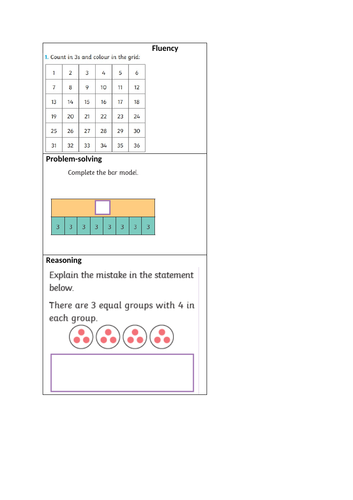













You will be downloading a Powerpoint for a series of lessons that cover the following objectives, stated by the NCETM for Year 4:
1 Pupils represent counting in threes as the three times table
2 Pupils explain the relationship between adjacent multiples of three
3 Pupils use knowledge of the three times table to solve problems
4 Pupils represent counting in sixes as the six times table
5 Pupils explain the relationship between adjacent multiples of six
6 Pupils use knowledge of the six times table to solve problems
7 Pupils use known facts from the five times table to solve problems involving the six times table
8 Pupils explain the relationship between multiples of three and multiples of six
9 Pupils use knowledge of the relationships between the three and six times tables to solve problems
10 Pupils represent counting in nines as the nine times table
11 Pupils explain the relationship between adjacent multiples of nine (1)
12 Pupils explain the relationship between adjacent multiples of nine (2)
13 Pupils use known facts from the ten times table to solve problems involving the nine times table
14 Pupils explain the relationship between multiples of three and multiples of nine
15 Pupils explain the relationship between pairs of three and nine times table facts that have the same product (1)
16 Pupils explain the relationship between pairs of three and nine times table facts that have the same product (2)
17 Pupils use the divisibility rules for divisors of three
18 Pupils use the divisibility rules for divisors of six (1)
19 Pupils use the divisibility rules for divisors of six (2)
The learning objectives of the lessons included in the unit of work are:
1: Identify the multiplier and multiplicand
2: Count in and multiply by 3
3: Count in and multiply by 6
4: find the relationship between 3 and 6 times tables
5: count in and multiply by 9
6: Find links between the 3, 6 and 9 times table
7: Find links between the 3, 6 and 9 times table
8: Identify numbers divisible by 3, 6 and 9 times table.
9: Multiply 3 digit numbers together.
Each lesson follows the structure and has a slide for each step:
Revisit
Address misconceptions
Vocabulary
Focus
Guided practice
Talk task
Deepen
Independent Practice
Next Step
Lessons come with accompanying worksheets that are structured into Fluency, Problem-solving and Reasoning tasks. Lessons are also accompanied by next steps which can be stuck into books.
The planning is heavily inspired by the NCETM but I have broken the lessons down into my own PowerPoints to ensure the steps taught are very small so all can access. This unit takes on a mastery approach to teaching maths and has been highly effective in my own classroom.
Included within the powerpoints are visual representations, small tasks for a ping-pong approach, stem sentences, high-level mathematical vocabulary, now/next/last visuals for SEN learners.
#ncetm #unit4 #year4 #mathsmastery =stemsentences #timestables
Something went wrong, please try again later.
This resource hasn't been reviewed yet
To ensure quality for our reviews, only customers who have purchased this resource can review it
Report this resourceto let us know if it violates our terms and conditions.
Our customer service team will review your report and will be in touch.